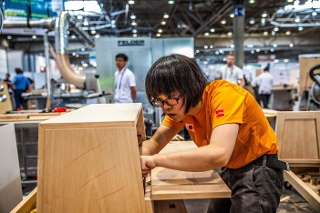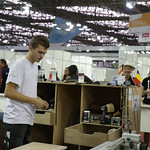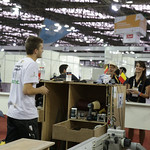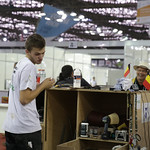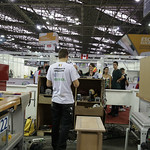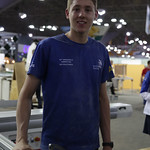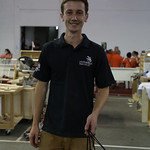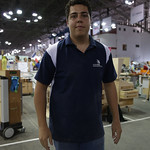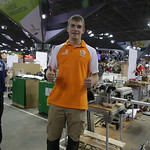Cabinetmaking
Skill Explained
Cabinetmaking covers the manufacture of free-standing and built-in furniture and units, using wood at the sole or main material. It may include the design of furniture, but normally comprises the creation of furniture and units from designs prepared by others. Cabinetmaking differs from joinery through the quality of the wood and associated materials used, and the intricacy and aesthetic quality of the finished items. There is, however, some overlap between cabinetmaking and joinery.
A cabinetmaker generally works on commercial and residential assignments of a high quality and value. He or she will therefore exhibit very high standards of skill and professionalism in order to justify clients’ expectations and willingness to pay. Most cabinetmakers work in small companies which have to be very sensitive to their reputation and market in order to sustain their businesses’ viability.
The cabinetmaker will produce furniture and fittings in a workshop, at least until installing fitted items. However, in order to meet clients’ needs, including for the items to add to the aesthetic qualities of their environment they will be placed in, he or she will know intimately where bespoke items are intended to be placed. For items produced speculatively rather than for known clients, the cabinetmaker will have a clear view of the types of location and setting that will show the items at their best.
The cabinetmaker will produce, interpret and/or adapt drawings, set out and measure, cut, form joints, assemble, install if need be, and finish to a high standard. The quality of his/her work will show in:
• The selection of the wood and other materials
• The placing of the wood to bring out its particular characteristics
• Construction techniques which allow for the natural movement of timber to achieve longevity and quality in the furniture piece
• The selection of additional materials including veneers and fittings
• The near-perfect fit of each part following accurate measurement, cutting and assembly, and
• The final appearance of the item
Work organization and self-management, communication and interpersonal skills, problem solving, innovation and creativity, working precisely and accurately are the universal attributes of the cabinetmaker. He or she assumes a high level of personal responsibility and autonomy. From working safely through to exceptional planning and organizing, accuracy, concentration and attention to detail to achieve an excellent finish every step in the process matters and mistakes are largely irreversible and very costly.
Modern technology and mass production have enabled furniture and fittings, previously available only to the wealthy, to be more widely available. However, for those with disposable income and an eye for quality, the cabinetmaker is able to produce furniture and fittings that are a lasting pleasure both to use and to look at. In this discerning market the outstanding cabinetmaker will always be in demand.
What the Competitors do at the Competition
The Competitor is judged on:
- Safe working practices
- Material fittings
- Jointing
- Preparation of surfaces
- Assembly
- Adjustable moving parts
- Interpretation of drawings
- Use of materials including solid wood, veneer and board
The Competitor is to construct a piece of furniture from a working drawing and written instructions, using the material supplied.
Competitors
Hamad AL Sareidi
United Arab Emirates
Manuel Chmiel
Germany
Dennis Cornelissen
Netherlands
Rylan Dekok
Canada
Karl Geue
Australia
Reinis Gusts
Latvia
Edward Harringman
United Kingdom
Michaël HENRY
France
Tran Van Huan
Vietnam
Jaakko Järvi
Finland
Musalman Kamal
Malaysia
Attila Laszlo
Hungary
Ho Jun Lee
Korea
Thomas Leyder
Belgium
YU-CHI LUO
Chinese Taipei
Cian Mulligan
Ireland
Syahrullah Noer
Indonesia
Diego Soares Oliveira
Brazil
Ergo Orumaa
Estonia
Shuhei Otani
Japan
Daniel Rabensteiner
South Tyrol, Italy
Mirco Signer
Switzerland
Thomas Vilain Rørvang
Denmark
Jacob Wozniak
United States of America
Manfred Zink
Austria
Experts

Vlassios Alpanis
United Arab Emirates

Christian Bachmann
South Tyrol, Italy

Declan Barrett
Ireland

Kasper Bøgelund
Denmark

Alfred Evers
Netherlands

Zoltan Fekete
Hungary

Shinichi Fukiya
Japan

Tran Van Han
Vietnam

Anuar Hassan
Colombia

Jason Hindes
Australia

Shih Kuang Hou
Chinese Taipei

Tobias Hugentobler
Switzerland

Jang Hei Kim
Korea

Florian Langenmair
Germany

Haralds Laucis
Latvia

Mick McGowan
Canada

Leo Moser
Austria

Amri Mustaffa
Malaysia

Christian Notley
United Kingdom

Alain Pierreisnard
France

Alberto SANTOLARIA
Spain

Mohammadjavad Sharifi
Iran

Osvaldo Souza
Brazil

Among Subandi
Indonesia

Robert Tobias
United States of America

Uve Uustalu
Estonia

Marko Varjos
Finland

Yves Woedstad
Belgium
Videos
A New Look at Skills
Autodesk Publisher 3D models*
Download for desktop
Download for mobile
Autodesk Inventor Data Sets**
* Open the 3D models on desktop with Autodesk Inventor Publisher. On mobile download the Autodesk Inventor Publisher Mobile Viewer app (iOS or Android).
** Students and Teachers can download Autodesk Inventor software via the Autodesk Student Community, Educational Institutions via Autodesk Academic Resource Centre (ARC).

